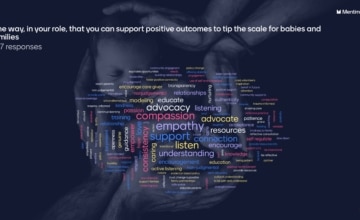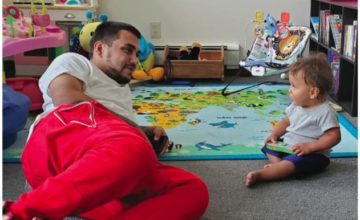by Janie Fletcher Huddleston, Director, National Infant–Toddler Court Program
Editor’s Note: The National Infant–Toddler Court Program has been collecting stories of families who have found support, compassion, and guidance through the involvement of the Safe Babies Court Team™ approach working in family courts across the country. They shared this story, written by Jessica Lertora and the adoptive family in Frederick County, Maryland.
We held tightly to each other’s hands, guiding a new toddler along as we walked into Frederick County Court House for Skylar’s first court hearing. Not only were we unfamiliar with the courthouse, we were also unfamiliar with the nuances of being resource parents as this was the first child joining our family. We also had no idea we were going to be part of a new initiative in Frederick County called the Safe Babies Court Team (SBCT). A distinct parallel process regarding relationships began to unfold.
While trying to navigate snack time for this new toddler, a woman stopped and spoke kindly with us. Her approach, demeanor, and conversation comforted us. At the time, we did not know we would later see this woman in a different capacity. Once we entered the court, we quickly recognized the kind woman: she was the judge presiding over Skylar’s case. We were relieved and reassured by her acceptance of our family. In fact, everyone from every involved agency was open and accepting of our intercultural family throughout the process.
That is how our story began. The SBCT program was a different way for everyone to collaborate as the child welfare system and the judicial system danced together, choreographed by the best interests of the child. The team formed to support a mother who struggled with addiction and the essential need to feel/be safe. Attorneys, social workers, resource parents, and mom came together to support a spunky, bright, and courageous toddler. It was through this process that we were able to focus on the intricacies of a strengths-based support initiative. Being an effective member of the team meant you had to build effective relationships that endured the undulation of rupture and repair. Our relationship began as, and continues to be, one of mutual respect, honesty, compassion, and fun with Skylar’s birth mother. We trust each other enough that Skylar’s birth mother shares details of her own personal struggles and triumphs with us. This relationship was forged through monthly Family Team Meetings and court hearings, as they proved to be valuable learning situations for all of us. We observed how each member of the SBCT was involved in helping the birth mom navigate the complexities of her circumstances as she worked for reunification and self-efficacy. In these team meetings, we learned to model empathy, set boundaries, establish healthy attachments, and express compassion in our relationship with the birth mom. Also, we learned about Skylar’s routines, family traditions, and personality so we could best honor Skylar’s cultural roots and support her personal development.
Being an effective member of the team meant you had to build effective relationships that endured the undulation of rupture and repair.
While serving as team members to help Skylar’s birth mom, we also had support from the department’s social worker and our home resource worker. They explained the case process and held our hands when court proceedings were especially tense. They actively listened to our questions and concerns, offered meaningful, useful information, and helped us to navigate a delicate discussion with the birth mom regarding our concerns about Skylar’s difficulties with speech and language, neurological consultations, and traumatic experiences. In contrast to what we heard of other resource families’ experiences, we felt valued as members of the team from the beginning of our work through the permanency process. Our opinions and perspectives were integral to all decisions being made. Even as we began the adoption process, each of the attorneys validated the strength of our relationship with the birth mom without inserting themselves as additional decision-making authorities at the last minute; they respected how much we had learned and could demonstrate as resource parents.
At the end of the dance, Skylar’s permanency plan turned to adoption. We gained a daughter and expanded our family. We videochat with Skylar’s birth mom, and we coordinate time together throughout the year during holidays that align with her cultural traditions. We maintain a healthy relationship that continues to withstand any rupture through our ability to unconditionally repair. Skylar is always the focus of most conversations with her mother, and she respects our sanctity as a family while also remaining a strong presence in Skylar’s life. The SBCT helped us understand that there is no single correct way to be a safe parent. Those involved in the SBCT respect several family structures, and that our parenting style suited the dynamics of our foster care situation since we were parenting a child of a different ethnicity. The parallel process in developing relationships at each level of the SBCT, for each team member, will never be a trivial concept; it is the glue that binds the team and the process together. This is where the “magic” of the SBCT lives.
Written by Leshia Chandler, Christopher Chandler, and Jessica Lertora.
Learn more about ZERO TO THREE’s National Infant-Toddler Court Program and the Safe Babies Court Team™ Approach.



